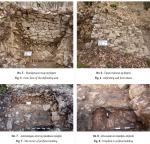Summary (English)
Gornopolsko Gradishte is a fortified settlement near the village of Velmej, Ohrid. Even though often mentioned in the literature, this site was never excavated. This report presents the results from the first archaeological investigations, which took place in 2016. The project had three aims: defining the sacral object (church) within the fortified area, whose remains were visible on the surface, defining the fortification wall and finding out the precise chronology of the site.
The sacral building represents a small church with an apse on its eastern side. It measures 7,5×4,5, with walls 0,7 m wide. There are two entrances to the nave, one from the West and one from the South. The building was constructed using local limestone blocks and lime mortar. The bedrock was used as a floor, and beaten clay was added where needed. In some places on the wall face, traces of façade layer were visible.
The contours of the fortification wall were visible on the surface. With the excavations it was established that the wall was 2,3 m wide, preserved in places up to 1,7 m in height. It was built using the same local stone material as for the church, with lime mortar as binding agent. Along the inner face of the wall, a cobblestone pavement was found on floor level, made of smaller stones and lime mortar.
Excavations were also carried out at a profane building within the fortified area, made of stones and mud. Inside the building, only one hearth was discovered in the SW corner, made of fragmented tegulae and clay, with a substructure of small pebbles and clay. Surprisingly, the excavations of 2016 revealed very few artefacts, but according to the few pottery fragments found around the hearth, the site was dated to the Late Antiquity.






![Download [PDF]](/excavation/skins/fasti/images/results/download_sml.png)
